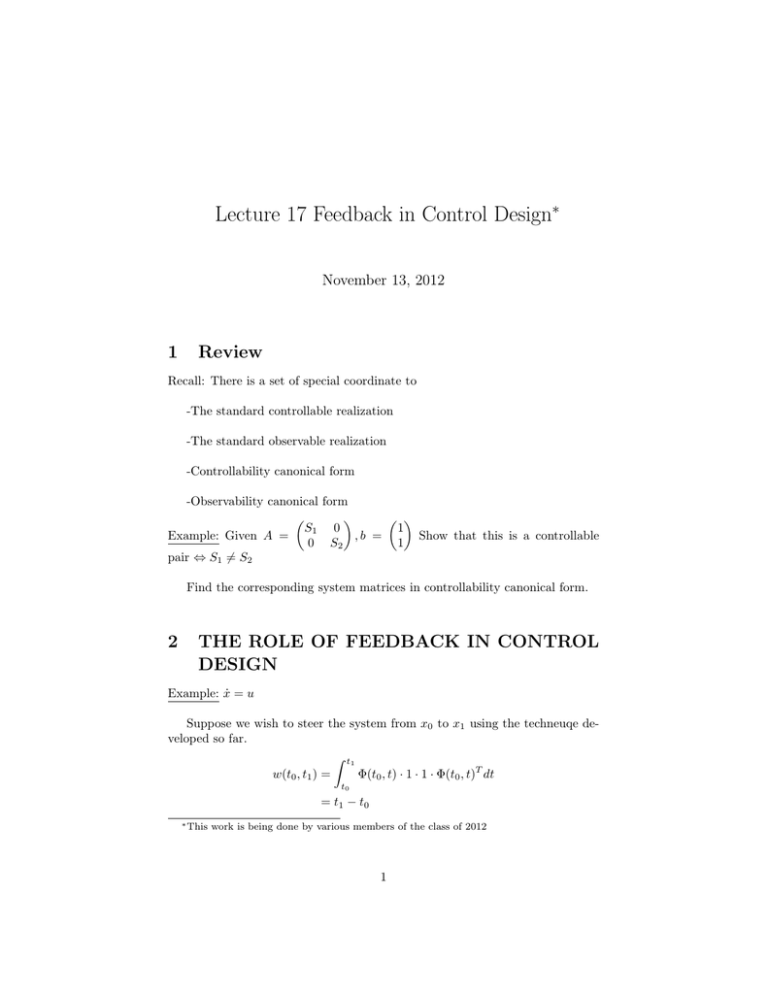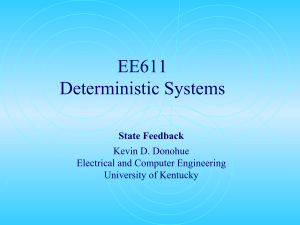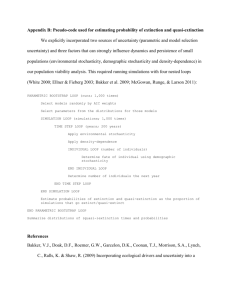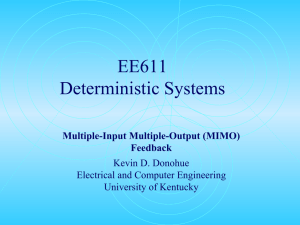Lecture 17 Feedback in Control Design 1 Review ∗
advertisement

Lecture 17 Feedback in Control Design∗ November 13, 2012 1 Review Recall: There is a set of special coordinate to -The standard controllable realization -The standard observable realization -Controllability canonical form -Observability canonical form S1 0 1 ,b = Show that this is a controllable Example: Given A = 0 S2 1 pair ⇔ S1 6= S2 Find the corresponding system matrices in controllability canonical form. 2 THE ROLE OF FEEDBACK IN CONTROL DESIGN Example: ẋ = u Suppose we wish to steer the system from x0 to x1 using the techneuqe developed so far. Z t1 w(t0 , t1 ) = Φ(t0 , t) · 1 · 1 · Φ(t0 , t)T dt t0 = t1 − t0 ∗ This work is being done by various members of the class of 2012 1 Control System Theory 2 x0 − Φ(t0 , t1 )x1 = (x0 − x1 ) = (t1 − t0 )η Let u(t) = −B(t)T Φ(t0 , t)T η = −1 · 1 · η x0 − x1 x1 − x0 = = −1 t1 − t0 t1 − t0 ( x1 −x0 t0 ≤ t ≤ t − 1 u(t) = t1 −t0 0 else This control law is said to be open loop. The challenge with applying open loop control is randomness and uncertainty in the physical world. Source of uncertainty: -model uncertainty -measurement noise -sensor errors -actuator errors - ... An alternative to open loop control is feedback control. For α > 0, u(t) = α(x1 − xt ). To pursue the discussion of uncertainty suppose the actual system is ẋ = x + (1 + δ)u where , δ are small. t x1 − x0 ds t1 − t0 t0 1 x1 − x0 = et (x0 + (e−t − e−t0 )(1 + δ) ) t1 − t0 x1 − x0 1 = et x0 − (e−t0 − e−t )(1 + δ) t1 − t0 t x(t) = e x0 + Z e(t−s) (1 + δ) Control System Theory 3 As → 0, this approaches x0 + (t1 − t0 )(1 + δ) x1 − x0 = x1 + x0 + δx1 − (1 + δ)x0 = x1 + δ(x1 + x0 ) t1 − t0 If > 0, this residual (terminal error) will be even larger. With the feedback control u(t) = α(x1 − x(t)), the closed loop dynamics is given as ẋ = x + (1 + δ)α(x1 − x) = [ − α(1 + δ)]x + α(1 + δ)x1 The equilibrium α= α(1 + δ) x1 α(1 + δ) − If > 0 is chosen to be sufficiently large, this can be made to be arbitrarily close to the desired x1 . Moreover,the equilibrium can be made arbitrarily fast. THEOREM: Let (A, B) be the controllable pair. Then given any real polynomial P (s) = sn + an−1 sn−1 + · · · + a1 s + a0 where n is the size of the square matrix A, there exists a real matrix K such that A + BK is a square matrix having P (s) as its characteristic polynomial. Remark: If (A, B) is a controllable pair, the feedback control u(t) = Kx(t) makes the closed loop system asymptotically stable at the origin for proper choice of K. Proof:(Only given in scalar input case–i.e. the case that B = b ∈ C n×1 ) We can assume that the coordinate system has been chosen s.t. 0 1 0 ··· 0 1 ··· . .. A= 1 −a0 · · · · · · −an−1 Control System Theory 4 0 .. b = . 0 1 Then the feedback matrix will be of the form K = (k1 , · · · , kn ) 0 .. bK = . (k1 , · · · , kn ) 0 1 0 0 ··· 0 .. .. .. . . =. 0 0 ··· 0 k1 k2 · · · kn 0 1 0 0 0 1 A + bK = . .. . . . k1 − a0 k2 − a1 ··· ··· ··· 0 0 .. . kn − an−1 x(k + 1) = Ax(k) + Bu(k) For discrete time asymptotic stability, the eigenvalues of A should be less than 1 in modulus. (I.e. the eigenvalues should be inside the unit disk) Why you can’t set velocity gains arbitrarily high with digital control systems. J θ̈ = τ (torque driven relating machine) First order: θ1 = θ, θ2 = θ̇. θ˙1 0 = 0 θ˙2 1 0 1 0 θ1 + θ2 J τ Suppose τ = −kv θ̇ − kp (θ − θd ) The closed loop system is 0 θ˙1 = k − Jp θ˙2 1 − kJv 0 θ1 + kp θd θ2 J Control System Theory 5 0 θ1 (t + h) − θ1 (t) =h k θ2 (t + h) − θ2 (t) − Jp θ1 (t + h) = (2 − 1 − kJv 0 θ1 (t) + b kp θd θ2 (t) J hkv hkv h2 kp )θ1 (t) − (1 − )θ1 (t − h) + (θd − θ1 (t − h)) J J J Continuous that feed back designs could be problematic in discrete time implementations depending on the sampling frequency: u = Kx(t) ⇒ closed loop system ẋ = (A + BK)x A + BK may have all l.h.p. eigenvalues, but if the system is implemented using digital elements, the feedback kw in this case will be u(t) = Kx(tj ) j ≤t≤j+1 By the variation of constant formula j+1 Z A eA(j+1−s) BKx(j)ds x(j + 1) = e x(j) + j = eA (I + Z 1 e−As BKds)x(j) 0 The requirement is discrete time eigenvalues are inside the unit dish.







